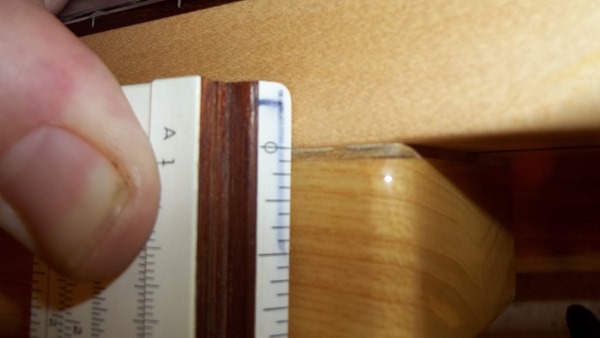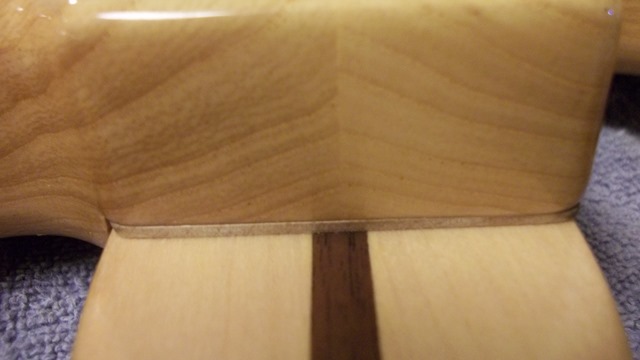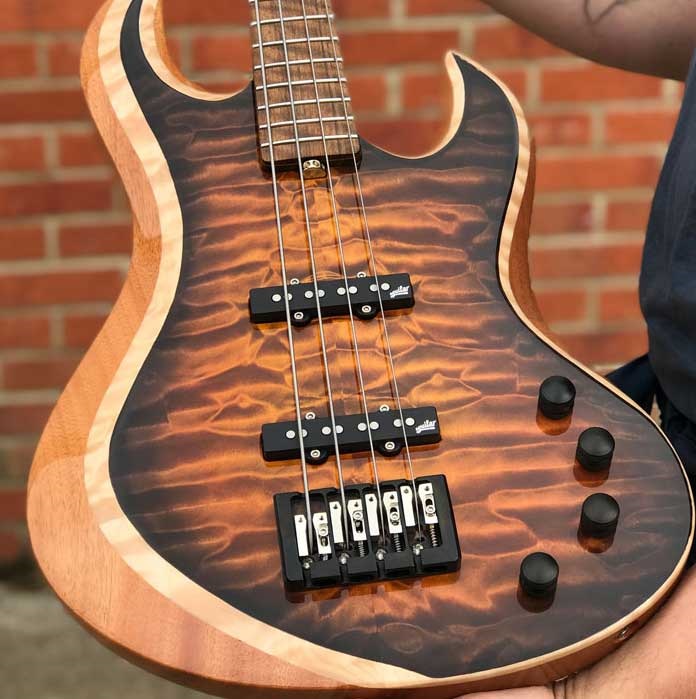A shim when referred to guitar neck usage is for all intents and purposes a thin spacer. In rare instances a shim is sometimes called a wedge, but the standard terminology used by luthiers for a thin wedge is to call it a shim.
What is the purpose of a neck shim?
To adjust the angle or pitch of the neck.
Why would you need to adjust the angle or pitch of the neck?
Let’s say you replace the neck on your bass guitar. You install it, string up, adjust your truss rod for proper bow, and then notice that the height of the strings is really high. You also notice that no matter how low you adjust the saddles, the strings are still sitting way too high above the frets.
It’s at that point you need a neck shim to change the angle so you can adjust strings to your desired string height.
Where is a shim placed?
Under the heel of a bolt-on neck where it butts against the neck pocket.
Alternatively, if you want to gain string height you can also use a reverse shim at the other end of the pocket, seen below:


What can be used for shim material?
There’s a long list of materials that could be used, most of which you already have.
You could use a guitar pick, milk jug plastic, a business card, 120 sandpaper, wood, a slim sheet of metal, etc. I’m sure you could think of many more.
Generally speaking, it is preferable to use a material that can but cut to fit across the width of the neck easily, which is why so many builders use business cards or sandpaper.
Is it required to use a neck shim whenever fitting a new bolt-on neck?
Not always. If after installing the neck and adjusting the truss rod you see that you can set your string height to your liking, then you don’t need a shim.
However, it is probably true you will need one, because the likelihood of a new bolt-on neck fitting exactly right usually doesn’t happen.
Why is a neck shim so often needed for new neck installations?
Because wood is unpredictable in how it will settle in once installed. No two necks fit exactly the same, even if they were cut from the same log.
Are there ways of adjusting without a shim?
Yes and no.
Seasoned luthiers can add mass to the neck heel and then “shave” it down to virtually eliminate any gap that a shim would ordinarily leave behind.
What this means is that no, you can’t adjust without a shim, but yes, a seasoned luthier can perform the adjustments in such a way where the energy transfer from neck-to-body basically acts exactly the same as if a shim were not present in the heel.
In other words, “gap-less” adjustment more or less acts like a natural extension of the neck heel as far as energy transfer is concerned because “everything is touching”.
Does the gap left behind by the shim adversely affect the tone?
That’s debatable.
Some builders firmly believe that the gap left behind by the shim significantly decreases the energy transfer from neck-to-body, “killing” the decay rate of a plucked note (which most known as “sustain”).
Others believe that as long as the bolt-on neck is installed properly and has a good, snug fit, the space does not affect decay rate whatsoever.
Is it true some builders purposely put in a shim gap for tonal purposes?
Yes. Some builders do believe that the gap created by a shim actually adds in a special tonal quality.
What tonal quality, specifically? It’s best described as “punch”. The energy of the neck according to the builder is “stopped short” at the heel, decreases note decay but increases loudness of certain harmonics; that’s where the “punch” comes from.
If you would like to experiment with certain gaps to see (or rather hear) what tonal differences there are, feel free to try it out.
As for how much gap you should put in there, I have no idea because it varies from instrument to instrument. And of course, bolt patterns vary wildly depending on what you have, because not everyone has a standard Fender 4-bolt setup.
What’s your experience with neck shims?
What worked? What didn’t work? How many times did you have to adjust before you got the correct angle? Post a comment or two with your experience(s).




Yeah, my ’63 P came with 2 shims made of vulcanized fiber, which you can buy by the square foot from a knifemaker’s supply shop. I don’t think it does much to the sound compared to such things as string choice, pickup scheme, wood, scale length, or basic construction (bolt vs. through-neck). It’s an adjustment a careful beginner will have no trouble with.
I’ve used both methods; with a shim only – I usually keep a little bit of Maple for this and I’ve also managed to shave the neck heel so it’s more of a wedge shape and it sits flat which means the neck is seated in the pocket solid as but it takes a lot to do this – throwing in a shim is much easier. it doesn’t take much height at all to make a big change to the neck angle though, so it’s all down to trial and error and personal string height taste.
When I add any wood to my basses I use the same species of wood that I’m adding to ie. maple neck= maple shim. I’ve never had to add a shim but it makes sense to me.
Like glass bedding a rife barrel to the stock, for the perfect fit. Depending on your need in telt you can build up the but of the neck as well. Both should be to hight or depth and then Scraped and or sanded to.
Perfection………peaceout…..
I used a shim made from a piece of laminate off an old speaker, all trace of glue sanded off for a smooth finish and to slim it down a fraction.
When i put a shim in a bass to lower the string hight i got a lot of fret buzz?
Neck to straight. Loosen truss-rod.
Tried thick Dunlop Hard guitar pick on bass side, Fender Medium on treble side to decrease ridiculous high action (like 1/4″) at last fret with neck trussed deadon flat – was somehow WAY too much, totalky changed way neck sat
After three or so tries, managed good action w/ three staggered (“pyramid pattern”) layers of masking tape at the screwhole on the LowE/bridgeward side only… Four might have made it perfect, but i got tired of messing around
HINTS, TIPS: masking tape lets you get whatever shape & thickness; apply tape TO NECK, not to pocket, easier that way; whenever experimenting on lower end instruments, ALWAYS use American or Japanese screws, Korean ones or worse will tear out or become too risky to continue with before youre happy….drilling them out is a HUGE pain, dont skimp 5 bucks here. Use proper steel. Not a single hint of deformation on threads, straightness, or the (+) heads with 30yo japanese screws after many rounds of adjustment